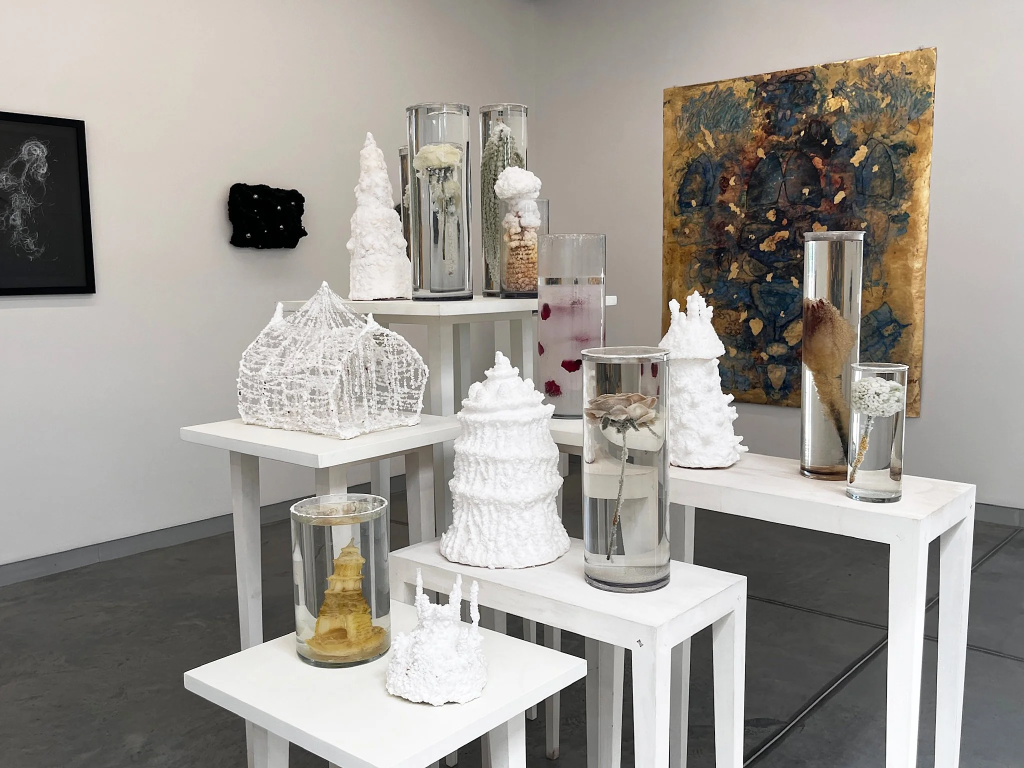
Sparkling surfaces abound in Backscatter, OVERLAP’s quietly radiant summer show of works by Funlola Coker, Katherine Mitchell DiRico, Jesse Kaminsky, Joetta Maue, Leah Piepgras, and Esther Solondz, curated by Alicia Renadette. On a clear summer midmorning, sunshine falls across shimmering layers of glass, crystal, gold leaf, copper, bronze, salt, acrylic, and clear liquid. Materials catch and refract light. The overall effect is of a hushed brilliance that draws you in, inviting a closer look.
Backscatter is a term most frequently used in astronomy, physics, and photography to refer to the diffuse scattering of particles and resulting reflections. Here, it refers to a shared investigation of light in the works of six artists based across Massachusetts and Rhode Island, whose distinct approaches are beautifully placed in dialogue in this show.
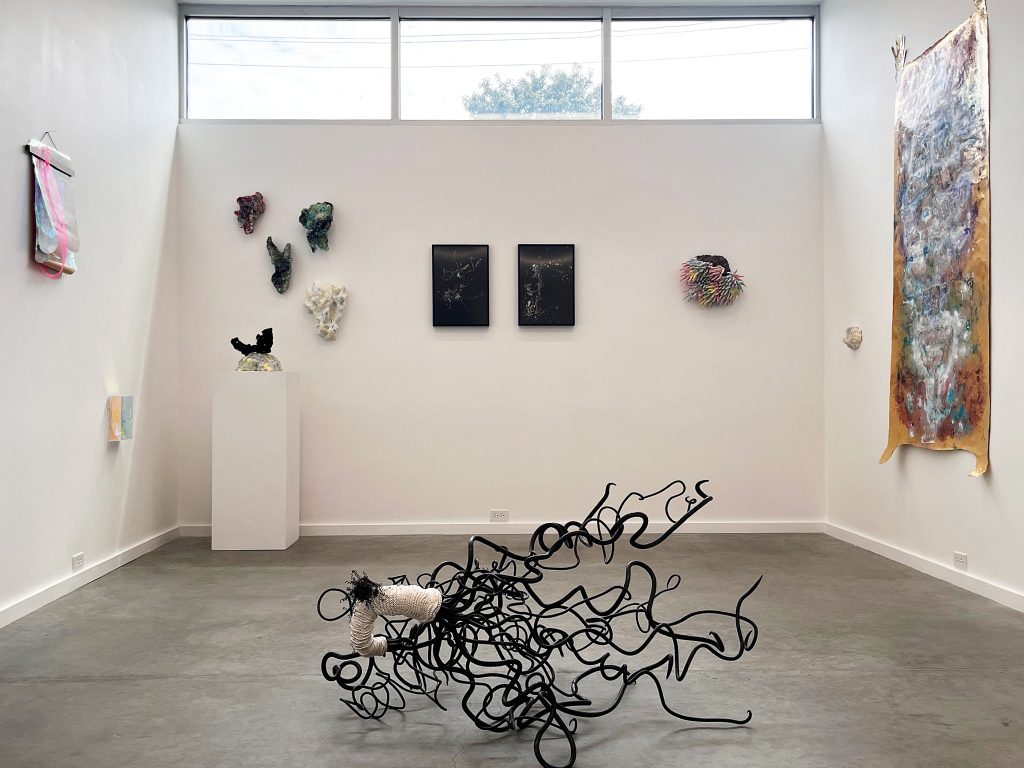
Katherine Mitchell DiRico’s lustrous, layered sculptures Drape and Spill recall the remnants of a gathering. Although who or what might have been celebrated is unclear, mirrored materials have been left behind, offering us our distorted reflections. Drape is part of a series titled Iridescent Intimacies: Camouflage, suggesting that reflection might also be a form of deflection or disguise. DiRico describes her use of iridescence and light as “portals.” Here, these portals invite us to conjure our own narratives while ushering us into the show. Later, her site-specific installation, Understories, offers up a different immersive experience. Where earlier works invite an intimate viewing, Understories takes up a full wall of the lower gallery. The wall is painted with loose brushstrokes and dripping lines that pool at the floor. String is pulled taut, extending at various angles across the work, and large lenses hang in front, suspended from the ceiling. Take the time to wait and watch, and you may enjoy the slow dance of lenses and light as they are activated by air.
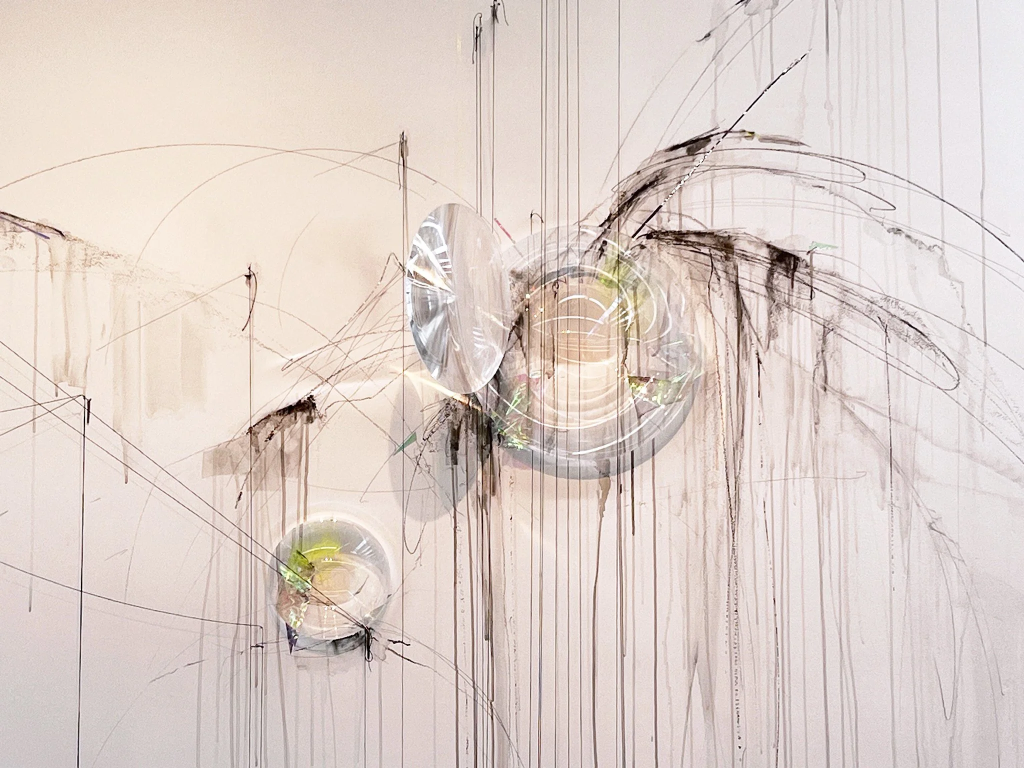
Jesse Kaminsky’s sculptures feel as if they’ve almost grown directly from the gallery walls. Coral-like ceramic tentacles reach out with gleaming glass orbs. Masses of sparkling beads ooze and drip in soft shades of green, blue, purple, and pink or black and silver made of a complex mix of silicone, epoxy, polyurethane, watercolor, acrylic, and glass. Some of Kaminsky’s sculptures are sprinkled with dark black oblong and bright white spherical beads. The effect is both glorious and grotesque, calling up larvae or bubbles. In the artist’s words, the power of the body is its ability to “grow a baby or a tumor.” In other works, smooth, glittering beads emerge from scaly clay bases in pale primary colors. Like DiRico’s pieces, these are also portals, but of a different sort. They conjure the organic forms of underwater growth, bodily interiors, and a little unsettlingly, the beauty of moldy decay. A multidisciplinary artist, Kaminsky works primarily in sculpture, sound, and performance, with a deep commitment to experimentation and iteration. The latter is clearly on display, as we get to discover and encounter an array of glass and clay sculptures throughout the show, all created in the past year.
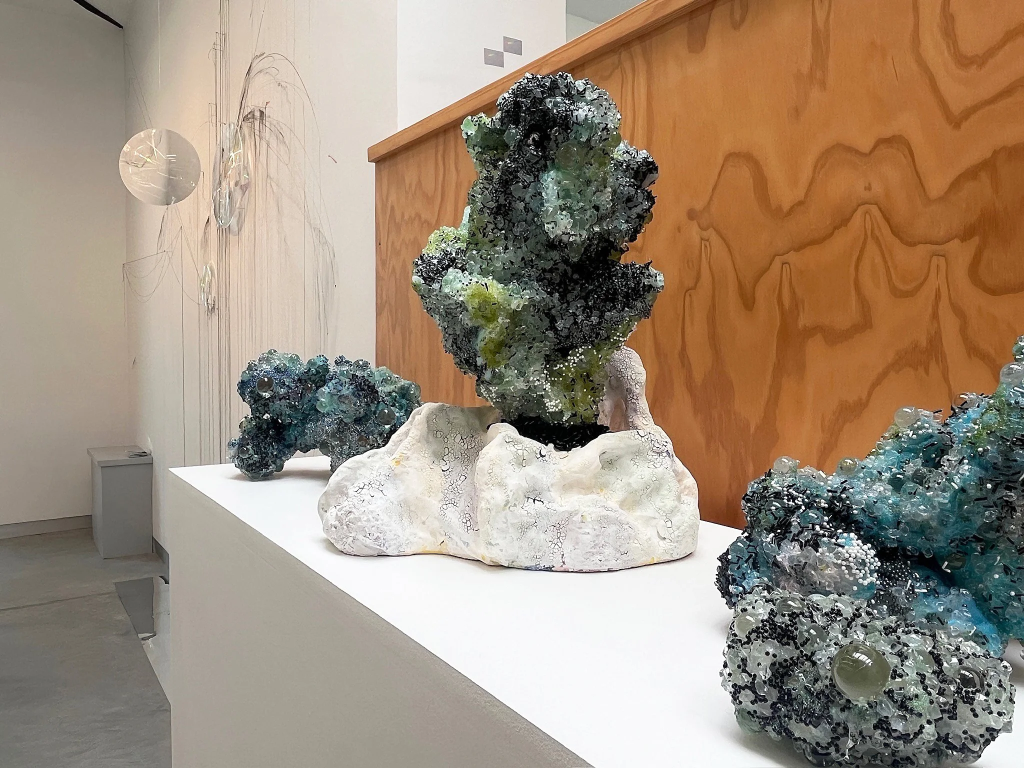
At first glance, Joetta Maue’s intricate drawings look like galaxies. But on closer inspection, they’re revealed as scenes of detritus—remains of paper, thread, and dust left on the studio floor. The everyday and the celestial merge and blend. Abstracted, Maue’s mark-making feels simultaneously intentional and organic. Delicate strokes of colored pencil swirl and emerge from rich matte black paper, suggesting mini universes, spider’s webs, and spaces unseen. Maue is a multifaceted artist with a sustained investigation into the beauty of ordinary things. Here, her drawings are paired with her incredible, site-specific installation Ordinary Rainbows. Composed of a series of overlapping digital photo prints of varying sizes that trace the arc of prismatic reflections across a white wall, Maue’s work documents various elements of a room: the corner of an upholstered chair, a thermostat, a painting. The words “A Journey” appear in a sans-serifed black font midway through the space. Where or what this journey leads to, we don’t know, but I’m taken as I traverse the gallery walls that Maue has transformed.
Look closer and you’ll discover an array of materials essential to the development of photographic processes installed on the walls alongside Maue’s photographs. A prism hanging from the ceiling, two miniature clear acrylic shelves display rough crystals on one wall while another holds a polished crystal column mounted on the lower wall at center. A series of smaller mirrored diamonds are glued to one corner, while a mysterious mountain of sand lies on the floor in the corner opposite. The accumulation of process and material culminates in an experience of the magic of the everyday and offers us a chance to revisit our own homes with new curiosity.
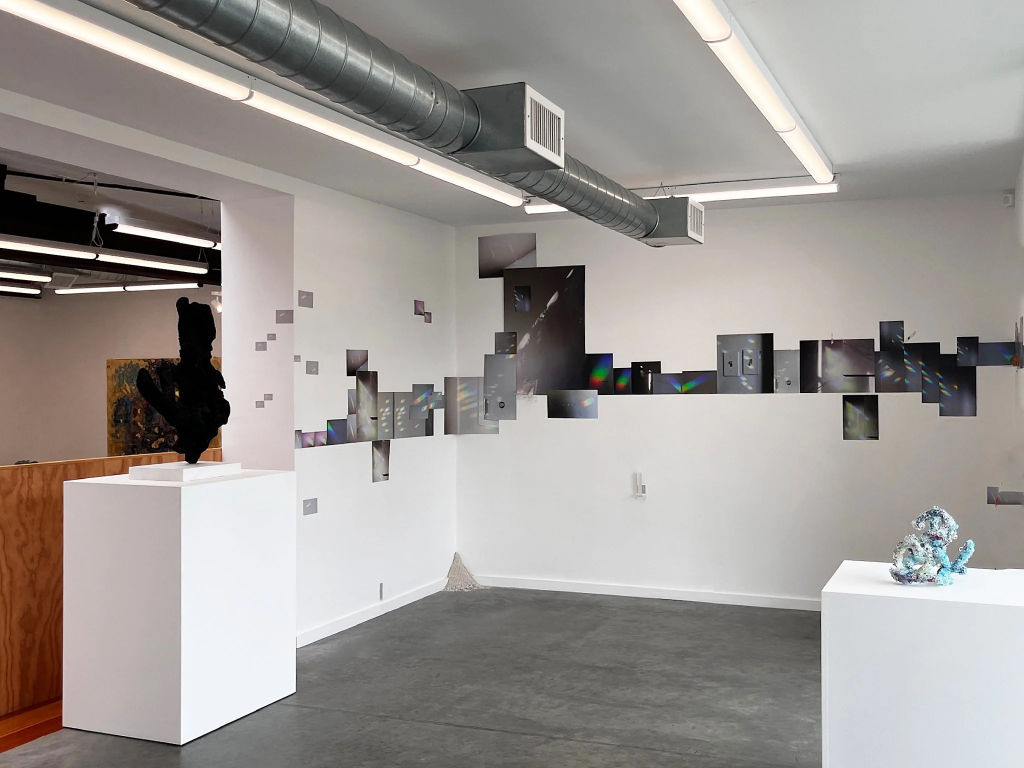
Funlola Coker’s work similarly bridges the everyday, this time connecting to the ancestral through metal. Each of the sixteen strips of sculpted copper that compose Baje (Deterioration) feels as if they have been ripped and torn by hand before being carefully placed along the gallery wall. Their satisfying thickness and weight, with grooved surface textures that move from dark to warm sheen, ask to be touched. The work cascades across the gallery wall, leading your gaze down to the floor at the center of the gallery, where a curling mass of metal tendrils held together by braided silver recalls a sea creature, a mass of hair, a 3-D drawing. Nigerian-born and Boston-based, Coker often works in steel, stone, and semi-precious metals to create works that abstract, defamiliarize, and recontextualize elements of the body, as well as imagery and objects of both Western and Yoruba cultures and cosmologies. Historical and Afrofuturist references recur throughout her work, especially visible in a smaller rectangular pair of tablets or talismans rendered in gleaming pewter and bronze—one embedded with cowrie shells in steel and overlaid with curving braids—the other with cutout patterned panels. For those who know how to interpret them, they suggest messages in a visual lexicon.
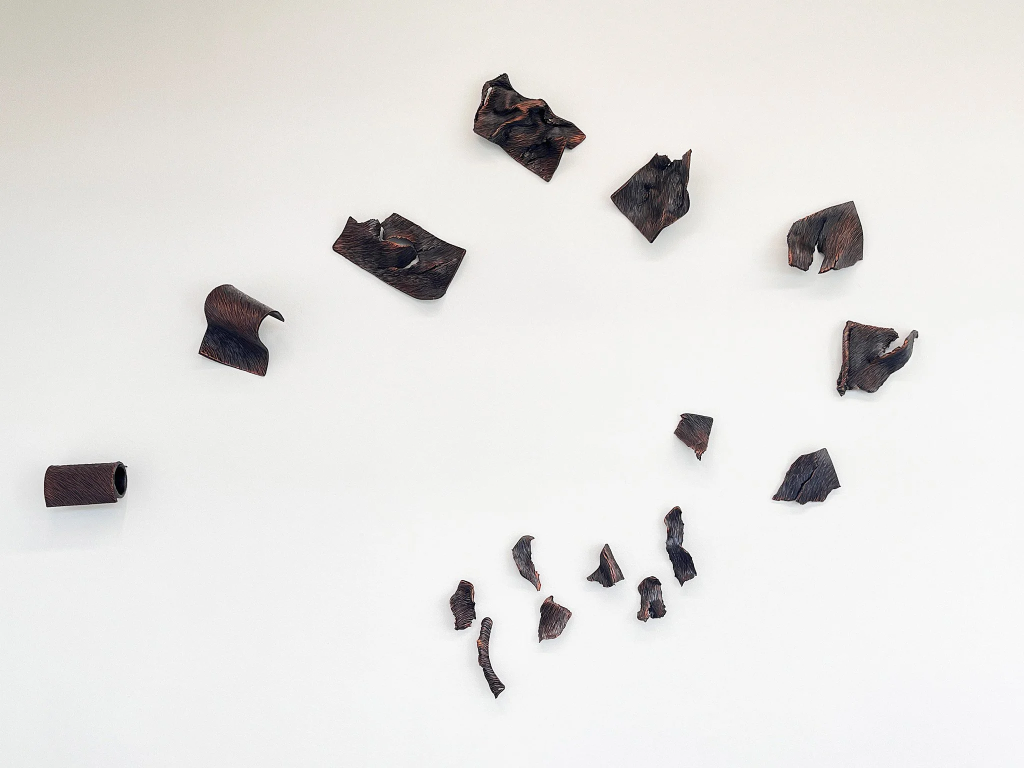
Leah Piepgras’ explorations of the body are visceral and arresting. With her larger-than-life works on luminous, gilded Tyvek, Piepgras traces the forms of internal organs outlined in dripping layers of white, turquoise, purple, deep and bright blues, and maroon paint that suggests blood. Lungs, intestines, ovaries, and other organs are framed by outstretched hands and feet—bodies fragmented, bodies laid open. For Piepgras, the human form, especially her own, is a frequent source of inspiration, yet Body Mandala, a new wall installation created this year, offers a closer and more intimate look at the body than her previous works. White plastercast body parts hang from 49 brass chains, suspended in a series of concentric circles. On the outermost rim hang toes of varying sizes, followed by fingers, eyes closed with feathery eyelashes, ears, noses, mouths with lips parted, revealing teeth, erect nipples, and, with increasing intimacy, anus, labia, and a navel at the center. The overall effect of the abstracted anatomy is more than the sum of its parts; it is a mapping of the self. The work is minimal, personal, masterful. Standing before it, I’m in awe.
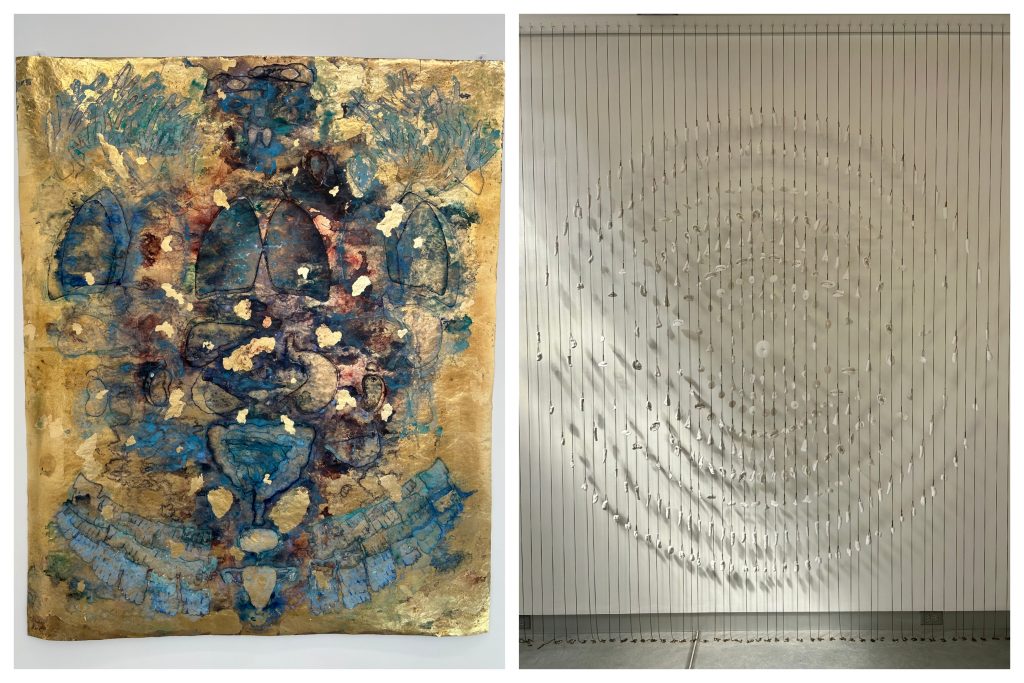
In the center of the lower gallery stand five white-painted tables of varying heights that hold a series of glass vitrines. Look inside and you will see sculptures crystallized and reminiscent of sea creatures and aquatic specimens. Look again and you will recognize red rose petals in one vitrine with single stem roses suspended in super-salinated water in another three. Alongside the vitrines in this installation, Esther Solondz has placed a series of intricate structures, some like castles, another one evocative of an elaborate architectural model made of thread. Solondz’s shiny, crystalline sculptures sparkle under gallery lights. She is interested in magic, and for this work, she has conjured castles from the everyday materials of salt, sugar, and water. Her crystal structures are composed of supersaturated saline solutions, and the imagined structures are buildings of her own devising. The suspension of organic materials is both impressive and slightly uncanny.
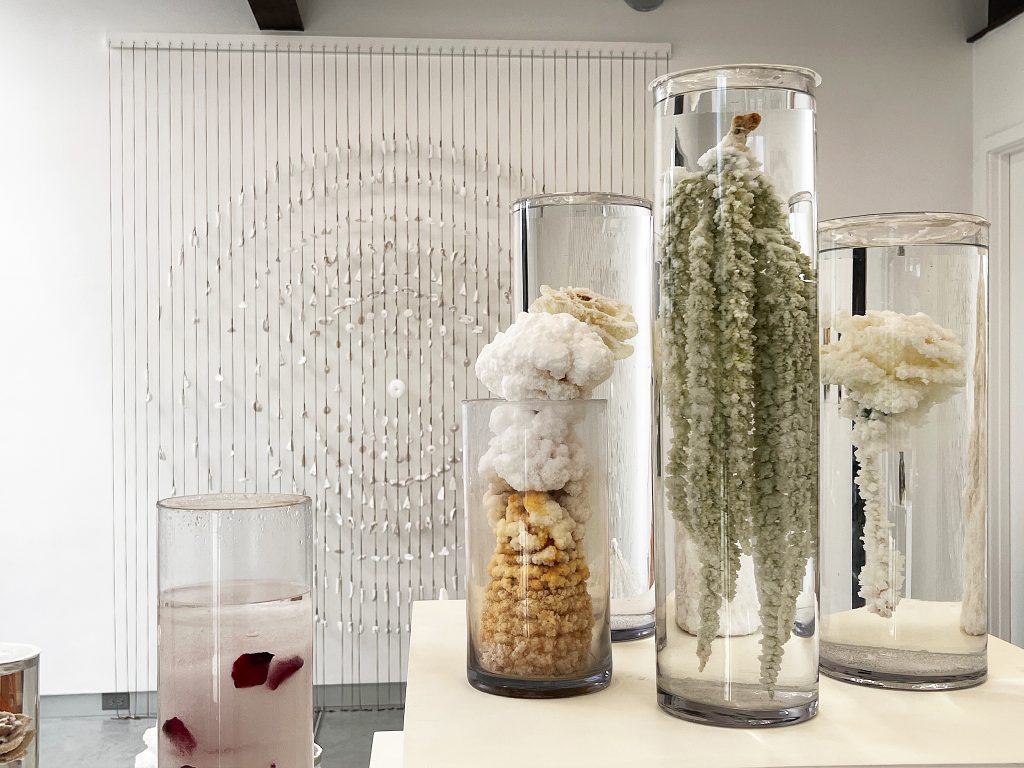
Iridescence and incandescence, Backscatter brings together work that invites you to move, flow, and meander through the gallery. Passage through the dual-level space is one of slow discovery, echoing the liquidity of materials and exploratory approaches of artists in the show. For the first exhibition to use the entirety of the gallery, Backscatter offers a gathering where each artist’s voice is distinct yet complementary. When leaving, you may feel a lightness, a sense of renewal, and fresh awareness of the many possibilities for new directions in making and being.
All photos courtesy of the author and OVERLAP.
Make your tax-deductible donation today and help Art Spiel continue to thrive. DONATE
Backscatter at OVERLAP, August 14 – September 13, 2025
112 Van Zandt Ave, Newport RI @overlapnewport
Artist Talk and post-exhibition walkthrough with Katherine Mitchell DiRico, Joetta Maue, Leah Piepgras, and Esther Solondz on Sunday, September 14th, 11 am
About the writer: Persephone Allen (she/her) is an educator, curator, cultural producer, and design historian based in Providence, RI. She brings a collaborative approach to creating courses, public programs, and exhibitions that catalyze dialogue, connection, and responsiveness, inviting us to examine art, design, and ourselves through multiple perspectives. She learns from and with her students at RISD, where she is an Adjunct Lecturer in the Theory and History of Art and Design and an educator at the RISD Museum of Art. She has also taught at Mason Gross School of the Arts – Rutgers University in New Brunswick, and held positions in public programming at the Isabella Stewart Gardner Museum in Boston, the American Folk Art Museum, The Frick Collection, and the Bard Graduate Center Gallery in New York. Recent projects include co-curating GO ‘HEAD, FIX YOU A PLATE at AS220’s Aborn Gallery in Providence with artist Jazzmen Lee-Johnson. @persephone_allen